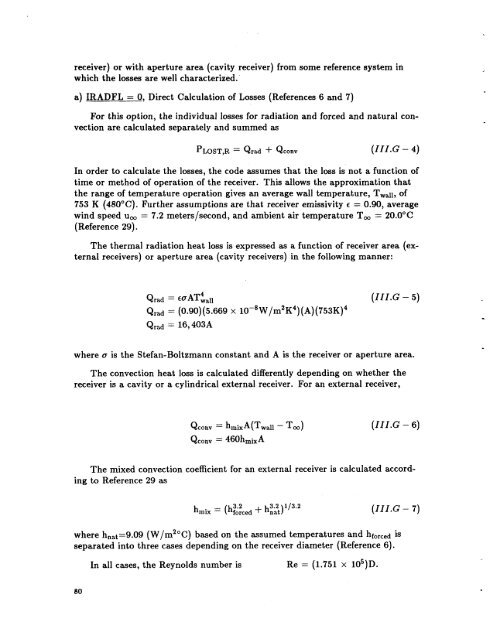A User's Manual for DELSOL3 - prod.sandia.gov - Sandia National ...
A User's Manual for DELSOL3 - prod.sandia.gov - Sandia National ...
A User's Manual for DELSOL3 - prod.sandia.gov - Sandia National ...
Create successful ePaper yourself
Turn your PDF publications into a flip-book with our unique Google optimized e-Paper software.
eceiver) or with aperture area (cavity receiver) from some reference system in<br />
which the losses are well characterized.<br />
a) IRADFL = 0, Direct Calculation of Losses (References 6 and 7)<br />
For this option, the individual losses <strong>for</strong> radiation and <strong>for</strong>ced and natural con-<br />
vection are calculated separately and summed as<br />
PLOST,R = Qrrtd + Qconv<br />
(1II.G - 4)<br />
In order to calculate the losses, the code assumes that the loss is not a function of<br />
time or method of operation of the receiver. This allows the approximation that<br />
the range of temperature operation gives an average wall temperature, Twall, of<br />
753 K (48OOC). Further assumptions are that receiver emissivity e = 0.90, average<br />
wind speed urn = 7.2 meters/second, and ambient air temperature T, = 20.0"C<br />
(Reference 29).<br />
The thermal radiation heat loss is expressed as a function of receiver area (ex-<br />
ternal receivers) or aperture area (cavity receivers) in the following manner:<br />
Qrad = EaATw,11 4<br />
Qrad = (0.90)(5.669 x 10-8W/m2K4)(A)(753K)4<br />
Qrad = 16,403A<br />
(1II.G - 5)<br />
where u is the Stefan-Boltzmann constant and A is the receiver or aperture area.<br />
The convection heat loss is calculated differently depending on whether the<br />
receiver is a cavity or a cylindrical external receiver. For an external receiver,<br />
The mixed convection coefficient <strong>for</strong> an external receiver is calculated accord-<br />
ing to Reference 29 as<br />
(II1.G - 7)<br />
where hn,t=g.Og (W/m2"C) based on the assumed temperatures and h<strong>for</strong>ced is<br />
separated into three cases depending on the receiver diameter (Reference 6).<br />
80<br />
In all cases, the Reynolds number is Re = (1.751 x 105)D.<br />
.

















